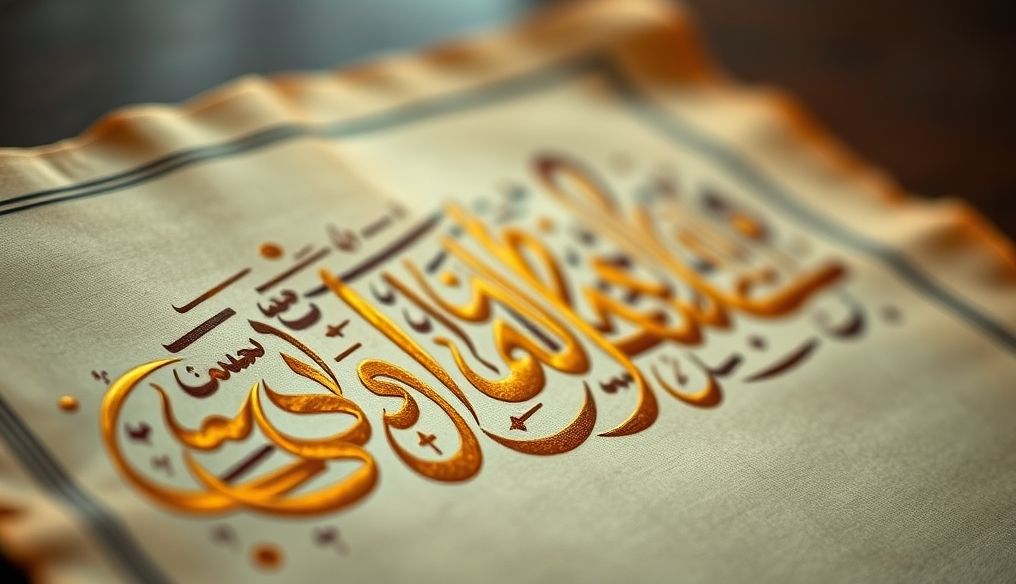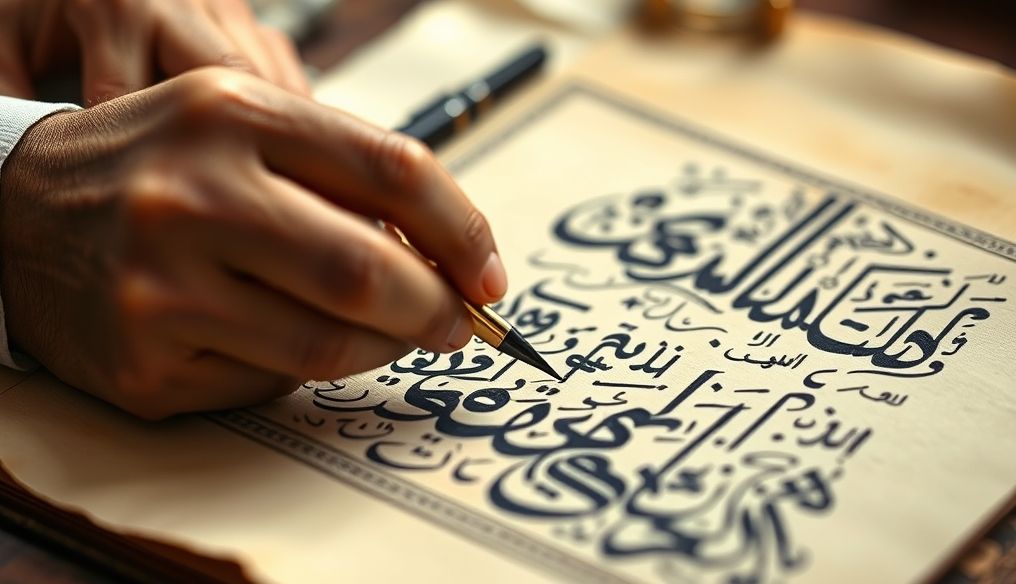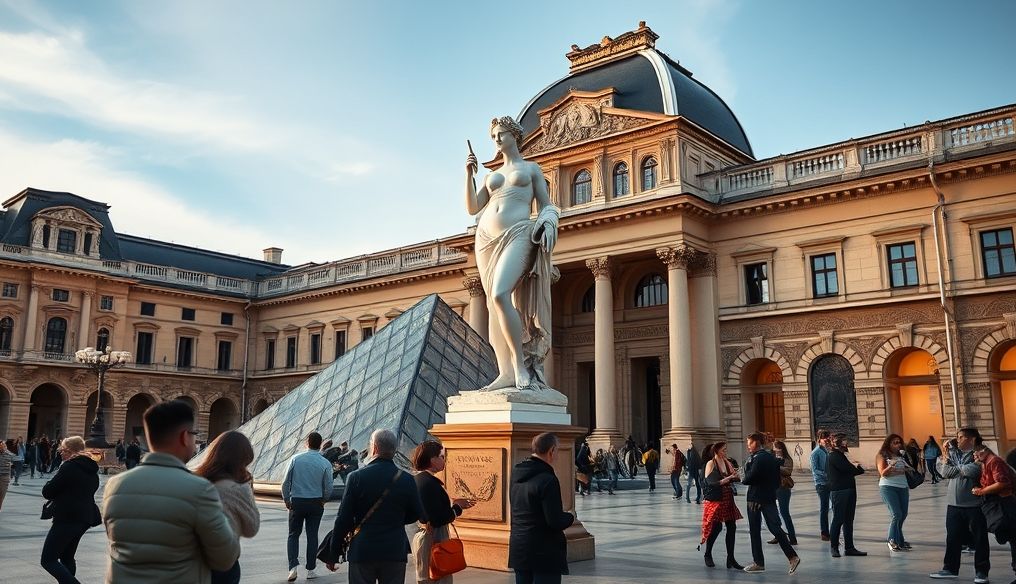Introduction: Arabic Calligraphy - Between Beauty and Depth
Arabic calligraphy, with its elegant complexities and dazzling aesthetics, has always captivated the hearts of onlookers. But is its role limited to being just a way of writing the Arabic language beautifully? Or does it carry deeper dimensions that go beyond mere decoration of words?
In this article, we will delve into the world of Arabic calligraphy to explore its history, types, cultural and spiritual connotations, and its impact on other arts. We will try to answer the question: Is Arabic calligraphy just beautiful writing or something much more?
Chapter 1: The History of Arabic Calligraphy - A Journey Through Time
Arabic calligraphy is not a product of the moment, but the result of a long and complex evolution over many centuries. Its roots can be traced back to the ancient Nabataean script used in the Nabataean region (northwest of the Arabian Peninsula) before Islam.
Nabataean Script: The First Beginnings
The Nabataean script, which appeared in the second century BC, is considered the great-grandfather of Arabic script. It was characterized by its simplicity and proximity to other scripts used in the region. Over time, the Nabataean script began to evolve and take on more distinctive forms, leading to the emergence of early Arabic script.
Kufic Script: The First Arabic Scripts
Kufic script is considered one of the oldest and most famous Arabic scripts. It appeared in the city of Kufa in Iraq, and became famous for its use in writing the first copies of the Quran. The Kufic script is characterized by its sharp angles and straight lines, giving it a formal and geometric character.
- Distinctive Features of Kufic Script:
- Sharp angles and straight lines.
- Formal and geometric character.
- Extensive use in writing the Quran.
Naskh Script: Ease of Reading and Dissemination
Naskh script appeared in the tenth century AD, and quickly became the most used script in everyday writing. Naskh script is characterized by its flexibility and ease of reading, making it the ideal choice for writing long texts and books.
Naskh script played a major role in the spread of knowledge and culture in the Islamic world, as it was used in writing sciences, literature, and arts.
Chapter 2: Types of Arabic Calligraphy - Diversity Reflecting Culture
The types of Arabic calligraphy are numerous and differ in their forms and characteristics, reflecting the cultural and artistic diversity in the Islamic world. Each type of Arabic calligraphy has its own aesthetics and distinctive uses.
Thuluth Script: The King of Scripts
Thuluth script is considered one of the most beautiful and complex Arabic scripts. It is characterized by its flexibility and interlacing, making it ideal for writing titles and decorations. Thuluth script is often used in writing verses of the Quran and decorating mosques and palaces.
Diwani Script: Elegance and Grace
Diwani script appeared in the Ottoman era, and became famous for its use in writing letters and official correspondence. Diwani script is characterized by its elegance and grace, making it ideal for expressing feelings and emotions.
Persian Script (Nastaliq): Persian Aesthetics
Persian script (Nastaliq) is considered one of the most beautiful Arabic scripts and the most widespread in Iran, Afghanistan, and Pakistan. Persian script is characterized by its flexibility and slope, making it ideal for writing poetry and literature.
Ruq'ah Script: Speed and Practicality
Ruq'ah script is a simple and practical script used in fast daily writing. It is characterized by its ease of reading and writing, making it the ideal choice for writing notes and short messages.
Ijaza Script: Certificate of Mastery
Ijaza script is a script used to write certificates of graduation in Arabic calligraphy. It is characterized by its beauty and elegance, and is considered a symbol of mastery and skill in the art of calligraphy.
Chapter 3: Cultural and Spiritual Connotations of Arabic Calligraphy
Arabic calligraphy is not just a tool for writing, but also a means of expressing cultural identity and spiritual values. Arabic calligraphy carries deep connotations that go beyond mere decoration of words.
Arabic Calligraphy in the Quran
Arabic calligraphy has a special place in Islam, as it was used in writing the Quran. Arabic calligraphy is considered an embodiment of the word of God, and reflects the beauty and sanctity of the Arabic language.
Arabic Calligraphy in Islamic Architecture
Arabic calligraphy is widely used in decorating mosques, palaces, and schools in the Islamic world. Arabic calligraphy is an essential part of Islamic architecture, and reflects the cultural and artistic identity of Muslims.
Arabic Calligraphy in Islamic Arts
Arabic calligraphy is used in many Islamic arts, such as ornamentation, gilding, and bookbinding. Arabic calligraphy is an essential element in these arts, and reflects creativity and innovation in Islamic culture.
Chapter 4: The Impact of Arabic Calligraphy on Other Arts
The impact of Arabic calligraphy was not limited to Islamic arts only, but extended to include other arts around the world. Arabic calligraphy has inspired artists and designers in various fields.
Arabic Calligraphy in Graphic Design
Arabic calligraphy is used in graphic design to add a touch of originality and beauty to designs. Designers use Arabic calligraphy in designing logos, advertisements, posters, and websites.
Arabic Calligraphy in Fashion Design
Arabic calligraphy is used in fashion design to add a touch of elegance and luxury to clothing. Designers use Arabic calligraphy in designing patterns and decorations on fabrics and clothing.
Arabic Calligraphy in Modern Art
Arabic calligraphy has inspired many modern and contemporary artists, who have used it in their artworks to express their ideas and feelings. Artists use Arabic calligraphy in painting, sculpture, and photography.
Chapter 5: Arabic Calligraphy in the Modern Era - Challenges and Opportunities
In the modern era, Arabic calligraphy faces new challenges due to the spread of technology and changing writing styles. However, there are also great opportunities to preserve and develop this art.
Challenges Facing Arabic Calligraphy
Among the challenges facing Arabic calligraphy:
- The widespread use of computers and the Internet.
- The difficulty of learning Arabic calligraphy for new generations.
- Lack of financial support for artists and schools specializing in Arabic calligraphy.
Opportunities Available to Arabic Calligraphy
Among the opportunities available to Arabic calligraphy:
- Using technology in teaching Arabic calligraphy.
- Encouraging artists and designers to use Arabic calligraphy in their works.
- Organizing exhibitions and art workshops to promote awareness of the importance of Arabic calligraphy.
Chapter 6: How to Learn Arabic Calligraphy - Practical Steps
If you are interested in learning Arabic calligraphy, there are many ways you can follow. You can enroll in training courses, study online, or learn independently through books and websites.
Basic Steps to Learn Arabic Calligraphy
- Choose the type of script you want to learn.
- Look for a specialized teacher or training course.
- Practice writing letters and words regularly.
- Study the works of famous calligraphers.
- Participate in exhibitions and art workshops.
Chapter 7: Famous Calligraphers in History
Throughout history, many talented calligraphers have emerged who have influenced the art of Arabic calligraphy and left unforgettable marks. Among these:
- Ibn Muqlah: Considered one of the founders of classical Arabic calligraphy.
- Ibn al-Bawwab: Developed the Naskh script and added a touch of beauty to it.
- Yaqut al-Musta'simi: Considered one of the greatest calligraphers in the Abbasid era.
- Hamdullah al-Amassi: A famous Ottoman calligrapher.
- Mohamed Othman: A contemporary Egyptian calligrapher.
Chapter 8: The Future of Arabic Calligraphy - An Optimistic Vision
Despite the challenges it faces, the future of Arabic calligraphy looks promising. There is a new generation of artists and designers who are striving to preserve and develop this art.
With the use of technology and the encouragement of creativity and innovation, Arabic calligraphy can continue to flourish and shine in the future.
Conclusion: Arabic calligraphy is not just beautiful writing, but a profound artistic expression that carries within it a rich history and culture. It is an art worth preserving and developing for future generations.




